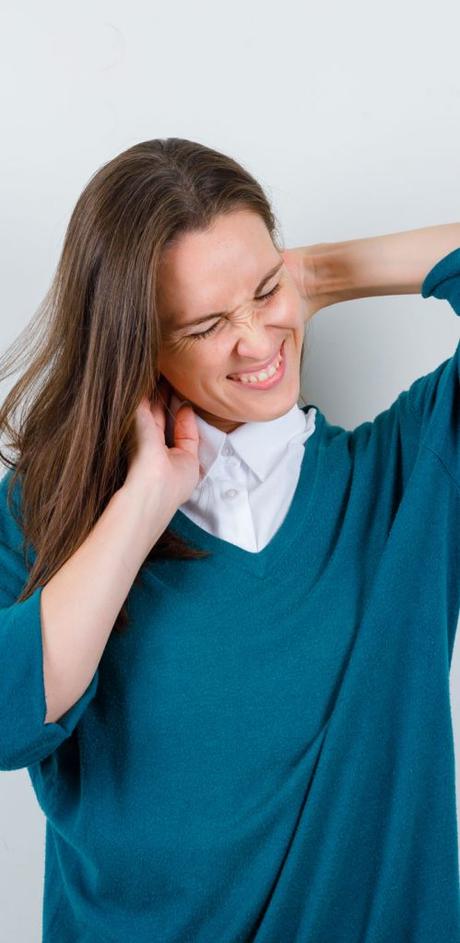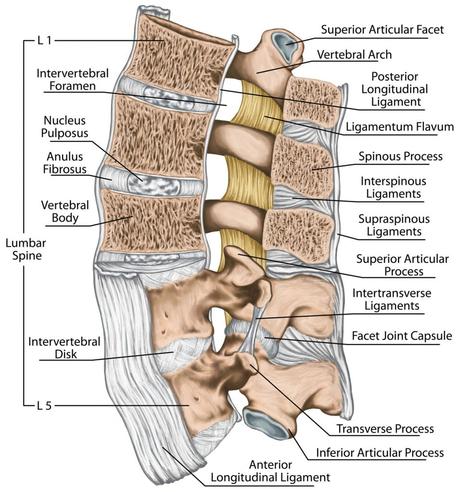Things like lacrimation, facial pain, blurred vision, equilibrium problems, and dizziness problems originate from the neck. We call that cervical vertigo or cervicogenic dizziness, eyelid twitching, redness in your eye, sinusitis, sore throat, ear popping, and lowered spatial awareness. So as you can see, there are somewhat strange symptoms sometimes that can arise from the dysfunction of your SCM. Stay with us to learn more about cervical vertigo

What Can Cause Problems with Your SCM or SCMs in Cervical Vertigo?
Infections and tumours – although this is quite rare, trauma like a car accident or a sports injury can damage an SCM. But probably the most common cause of SCM irritation we see in clinical practice is the poor posture from looking at our phones and spending too long in front of our computers or TVs. We’re sitting more than we’ve ever sat. Poor posture and sitting too long are the most common cause of malfunction or dysfunction of the SCM muscle. So what can you do at home to help alleviate some of those symptoms we just discussed? You can do two things very quickly that can help tremendously alleviate some problems with the dysfunctioning SCM muscle.
- One involves trigger point therapy or ischemic compression to trigger points within the muscle.
- And another one is stretching the muscle.
What we find the most important thing is that you work out the trigger points before stretching for it to be the most beneficial to help with an SCM problem. The first thing you’re going to do to find trigger points is that you’re going to use a pincher grasp to find the muscle. You’re going to turn your head and slightly flex down, and the muscle should pop out. As you can see, you’re going to grab the muscle between your thumb and your index finger, and then you can come back to the center and what you want to do – you want to palpate or put some compression up and find any tight or trigger points that elicit some pain or referred pain. You’ll know you’re on one when you find a tender spot – there is one right there – and as we compress very gently, we can feel that refer to the back of our head. We know that’s a good indication of an area of the muscle that might not function correctly. So you want to put a little bit of pressure and hold it for a few seconds or until the sensation of the referred pain or discomfort minimizes. But you want to work your way up, finding tender nodules or trigger points and compressing them very gently to elicit some discomfort. You could elicit some of the symptoms we discussed, such as headaches, neck pain, and dizziness. These could all be possible from trigger points within your SCM muscle. And you can work right up, right up to the base of the skull. In the mastoid process, there are often trigger points or tender points at the origins and the muscle’s insertion. So to find the origin, what you want to do is you want to flex the muscle, and you want to feel; there are two areas where the muscle originates, the clavicle, which is the collarbone and the manubrium or the sternum. And as you flex the muscle, you can feel both areas. So these are good areas to look for trigger points. Be gentle; some sensitive tissues are below this muscle, blood vessels, and nerves. You want to stay away from those, but you can be on the muscle and work your way from the bottom to the top. And just gently, when you find a nodular trigger point, treat it immensely, very gently, specifically until the discomfort or the referred pain diminishes. Make sure you check both of these muscles for trigger points or tender nodules before you move on to the stretch. We’re going to explain to you next. This muscle can be stretched in a variety of ways.

Two Stretches that Help Alleviate Tension in Your SCMs
We’ll show you two stretches that are our favourites and work best to help people alleviate tension or tenderness in your SCMs. As we said, start with the trigger points and move immediately to the stretches. So the first step is the stretch, so we’re going to take the neck, and we’re to just keep the shoulders down, move to the side, and move the neck all the way. And you might want to put a little more pressure on your hand. It feels good. Hold the stretch for a minimum of 30 seconds at least twice daily. We’ll show you a stretch now to help stretch out the bottom part, both at the clavicle and at the sternum or the clavicle and the sternum. What we’re going to do, we’re going to turn our heads, we’re going to extend slightly back, and you’re going to feel that when we move down, you’re going to feel the clavicle part. And if you move slightly up, you’ll feel closer to the center at the sternal part. One thing you want to be careful about if you know you have underlying neck problems is sometimes, when you extend your neck, it can irritate the joints at the back of your neck. If any pain happens in the back of the neck when doing this stretch, this stretch is probably not for you.
How to Fix a Pinched Nerve in the Neck How To FIX Forward Head Posture (Hunched Forward)What Connects Poor Posture and Neck Pain
The average human head weighs about eight pounds daily. We all walk around with a bowling ball, our heads balancing on a toothpick: our necks. We are designed this way to allow for the full range of motion that we all know and love, even under the best circumstances. This place is a lot of stress on your spine but leaning forward even just 15 degrees pushes that weight up to 30 pounds in with the 30 degree tilt it’s closer to 40 additional pounds driving a car working on the computer, and using a tablet and phone all usually result in less than ideal posture when you start to lean forward it places a tremendous amount of extra pressure on the discs in your neck and spine this can cause increased compression and lead to pain even just a few inches of forward head posture can double or triple the amount of stress on the spinal joints of your neck take a moment today at work and notice if your shoulders are rounding and your head has moved forward, and the upper back is hunched over if you notice yourself slouching into that type of posture let us know we’d love to provide you with some exercises that you can do at work to help strengthen the muscles supporting your spine and combat these muscle imbalances remember the more time you spend in that posture the more likely you are to suffer from head or neck pain.

What Are The Cause of Neck Pain, Headaches, and Cervicogenic Dizziness (Cervical Vertigo)
The sternocleidomastoid, or SCM for short, is the most superficial and most significant muscle in the front part of your neck. This article will show you how it can cause neck pain, headaches, cervicogenic dizziness(Cervical Vertigo), and various other strange symptoms. We will also show you how to treat this muscle at home to help alleviate dysfunction in your SCM. Today we’re gonna discuss how the sternocleidomastoid or the SCM might just be the cause of your problems. The sternocleidomastoid gets its name from its origin and insertion. So the sternocleidomastoid originates from two different parts of the lower neck, the sternum and the clavicle, the Sterno-cleido, and rises to attach to the mastoid process of the temporal bone in the back of the neck. Hence the name sternocleidomastoid, although people call it SCM for short because it’s much easier to say this muscle is quite complex in that it allows you to turn your head as the muscle shortens. You turn your head to the opposite side. It also allows for some lateral flexion. And finally, it allows you to flex your neck forward when both sternocleidomastoid muscles contract bilaterally or simultaneously. This muscle is also fascinating in terms of the symptoms it can create when it’s not working correctly. Things like headaches, neck pain, decreased range of motion, Wry neck or torticollis. However, there are more complex symptoms that can arise.
In the case of cervical vertigo.

